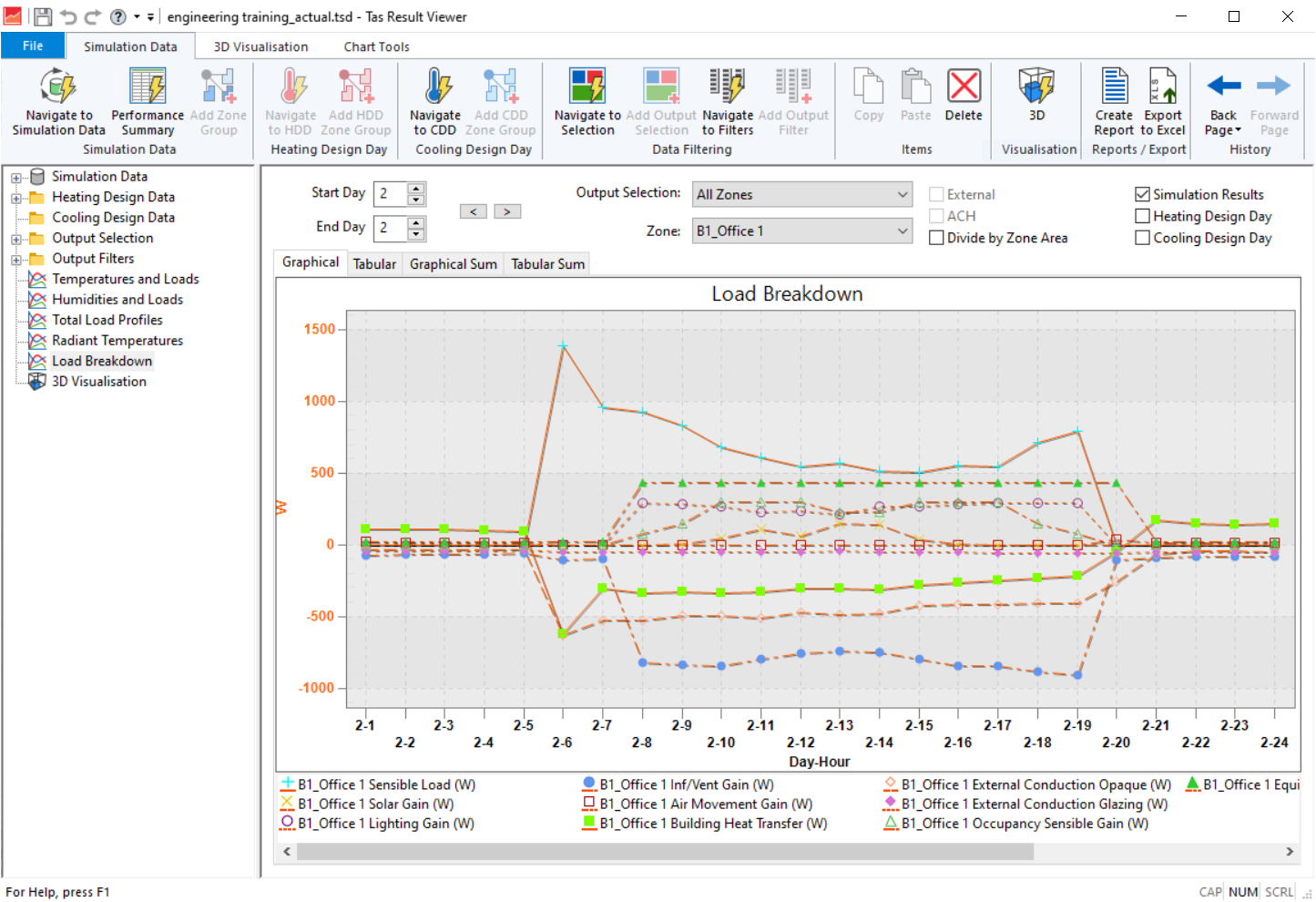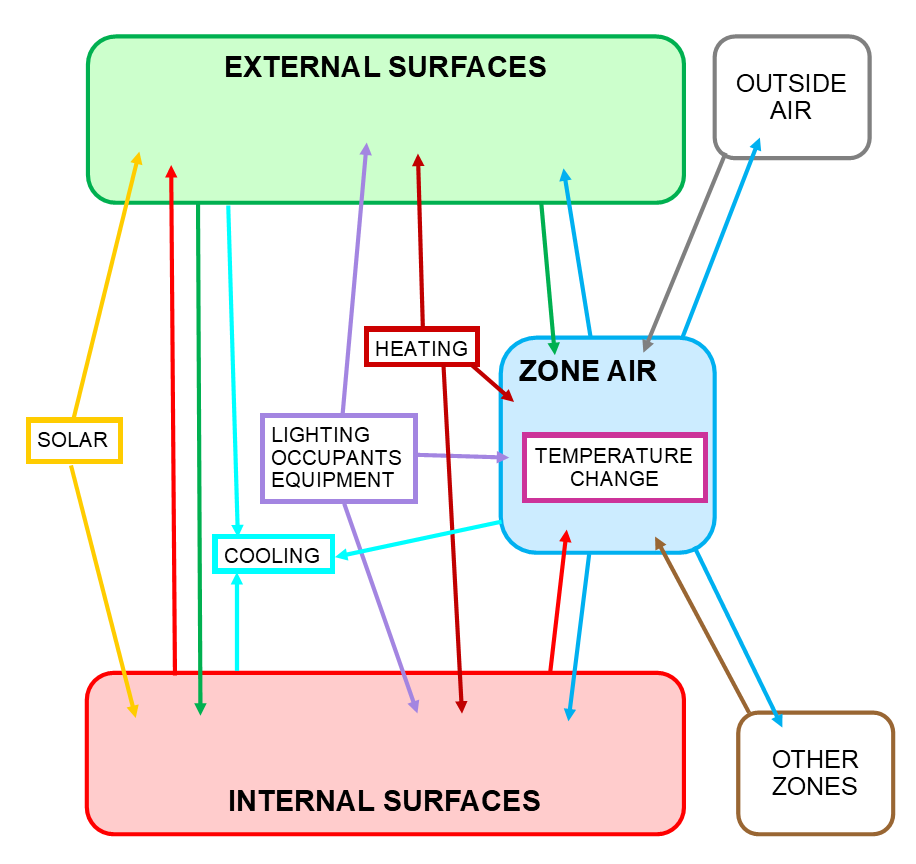Load Breakdown¶
The load breakdown shows the sensible energy balance for a zone (note that this considers heat flow in and out of the inner side of the zone’s surfaces as well as the zone air). For any zone on any given hour, the result values in the load breakdown will sum to zero (save rounding errors).

Heat Flows and Results Series¶
The diagram below shows the heat flows considered in the load breakdown.
For the purposes of the diagram and text below, surfaces which are exposed the air or exposed to the ground are both called “external”, and link, adiabatic, or internal surfaces are all called “internal”. Note that in the TSD results, heat flows for opaque and glazed external surfaces are shown separately, but they are shown together in the diagram for the sake of clarity. Note that heat flows in and out of surfaces are for the inner side of the surface only (i.e., the side facing the zone in question); as most constructions (except glazing) have thermal mass, this does not mean there will be an identical and opposite heat flow on the other side of the surface.
Note that in the TSD results, occupancy, lighting, and equipment are all shown separately, but they are shown together in the diagram for the sake of clarity.

Here is a list of all the heat flows and the TSD results series to which they are assigned, either adding to or subtracting from the value.
SOLAR INTO EXTERNAL SURFACES: + solar gain, - external conduction
i.e., if X watts of solar gain enters the inner side of an external surface, X is added to the total solar gain result value and X is subtracted from the total external conduction result value.
SOLAR INTO INTERNAL SURFACES: + solar gain, - building heat transfer
Note that solar gain and other radiant gains do not directly or immediately enter the zone air.
LIGHTING INTO EXTERNAL SURFACES: (radiant): + lighting gain, - external conduction
LIGHTING INTO INTERNAL SURFACES: (radiant): + lighting gain, - building heat transfer
LIGHTING INTO ZONE AIR: (convective): + lighting gain
OCCUPANCY SENSIBLE INTO EXTERNAL SURFACES: (radiant): + occupancy sensible, - external conduction
OCCUPANCY SENSIBLE INTO INTERNAL SURFACES: (radiant): + occupancy sensible, - building heat transfer
OCCUPANCY SENSIBLE INTO ZONE AIR: (convective): + occupancy sensible
EQUIPMENT SENSIBLE INTO EXTERNAL SURFACES: (radiant): + equipment sensible, - external conduction
EQUIPMENT SENSIBLE INTO INTERNAL SURFACES: (radiant): + equipment sensible, - building heat transfer
EQUIPMENT SENSIBLE INTO ZONE AIR: (convective): + equipment sensible
RADIANT FLOW FROM EXTERNAL TO INTERNAL SURFACES: + external conduction, - building heat transfer
RADIANT FLOW FROM INTERNAL TO EXTERNAL SURFACES: + building heat transfer, - external conduction
HEAT FLOW FROM EXTERNAL SURFACES TO ZONE AIR: + external conduction
HEAT FLOW FROM ZONE AIR TO EXTERNAL SURFACES: - external conduction
HEAT FLOW FROM INTERNAL SURFACES TO ZONE AIR: + building heat transfer
HEAT FLOW FROM ZONE AIR TO INTERNAL SURFACES: - building heat transfer
NET HEAT GAIN FROM OUTSIDE AIR DUE TO AIR MOVEMENTS: + inf/vent gain
NET HEAT LOSS TO OUTSIDE AIR DUE TO AIR MOVEMENTS: - inf/vent gain
NET HEAT GAIN FROM AIR OF OTHER ZONES DUE TO AIR MOVEMENTS: + air movement gain
NET HEAT LOSS TO AIR OF OTHER ZONES DUE TO AIR MOVEMENTS: - air movement gain
HEATING EMITTER INTO EXTERNAL SURFACES: (radiant): + sensible load, - external conduction
HEATING EMITTER INTO INTERNAL SURFACES: (radiant): + sensible load, - building heat transfer
HEATING EMITTER INTO ZONE AIR: (convective): + sensible load
COOLING EMITTER INTO EXTERNAL SURFACES: (radiant): - sensible load, + external conduction
COOLING EMITTER INTO INTERNAL SURFACES: (radiant): - sensible load, + building heat transfer
COOLING EMITTER INTO ZONE AIR: (convective): - sensible load
ZONE AIR TEMPERATURE INCREASE: - building heat transfer
ZONE AIR TEMPERATURE DECREASE: + building heat transfer
External Conduction and Building Heat Transfer¶
EXTERNAL CONDUCTION (divided in TSD between opaque and glazed surfaces) is the net heat flow OUT of the inner side of the external surfaces
Positive: radiant loss to internal surfaces, heat loss to zone air, cooling emitter
Negative: solar gain, lighting radiant, equipment radiant, occupancy radiant, radiant gain from internal surfaces, heat gain from zone air, heating emitter
BUILDING HEAT TRANSFER is the net heat flow OUT of the inner side of the internal surfaces. It also includes any heat energy associated with a temperature change in the zone air
Positive: radiant loss to external surfaces, heat loss to zone air, cooling emitter, zone air temperature decrease
Negative: solar gain, lighting radiant, equipment radiant, occupancy radiant, radiant gain from external surfaces, heat gain from zone air, heating emitter, zone air temperature increase
Note that because these results series contain so many heat flows, it is quite possible, for example, to have a negative value for external conduction when the effect of radiative gains outweighs the heat flow out of the surfaces, despite the fact that the relative temperatures of zone, wall, and outside air might suggest a positive value.
Heat Flow Balance¶
As mentioned before, the results in the load breakdown will sum to zero for any given zone on any given hour. The sections above demonstrate how this is possible; heat flows have been marked as negative or positive to ensure that it is always the case. One can also see, for example, that if the heating or cooling were to be removed on a particular hour, there would be a corresponding change in zone air temperature which would change the value of building heat transfer and restore the balance.